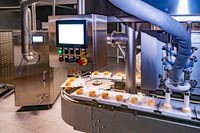Food contact
Hydrocarbons that come into contact with food must fulfil certain requirements to ensure that they do not pose a health risk. These requirements vary by country and regulatory authorities, but there are some general criteria that often apply:
Resistance and inertness: The hydrocarbon should be chemically inert, i.e. it should not react with the food or decompose under the conditions to which it is exposed.
Odour and taste neutrality: It must not have any inherent odour or taste that could be transferred to the food.
Compliance with legal regulations: It must comply with the legal regulations of the country in which the product is used. This includes authorisations by food safety authorities such as the European Food Safety Authority (EFSA) in the European Union or the Food and Drug Administration (FDA) in the United States.
Migration tests: The hydrocarbon must pass migration tests to ensure that no hazardous amounts of chemicals are transferred from the material into the food. Currently, viscosity and C-chain length are a requirement for the use of mineral white oils products.
Purity: The hydrocarbon must have a high degree of purity to prevent the accumulation of impurities that could migrate into food. The use of products which fill pharmaceutical purity requirements is an important parameter.
Conformity with specific standards: Specific standards or certifications may be required for certain applications, such as direct food contact or use in sensitive environments (such as baby food).
Traceability and documentation: The origin and processing of the hydrocarbon should be documented and traceable to ensure compliance and quality assurance.
Examples of relevant regulations include:
NSF H1 certification:
This certification is required for lubricants used in machinery and equipment that may come into direct contact with food.
An H1-certified lubricant must be considered "food grade," which means that it does not pose a health hazard if accidentally contaminated at levels of no more than 10 parts per million (ppm).
Ingredients:
Lubricant ingredients must comply with regulations and be safe to use. Substances that are classified as carcinogenic, mutagenic or toxic are generally not permitted.
Labelling and documentation:
Products must be clearly labelled to avoid confusion. In addition, safety data sheets and product information are required to provide information on the composition and safe use of the lubricant.
Migration limits:
Similar to other materials that come into contact with food, lubricants must only migrate into the food in very small quantities so as not to exceed the MRLs (Maximum Residue Limits).
Regulations in different countries:
In addition to the NSF standards, additional or deviating regulations may apply in various countries. In the EU, for example, there is Regulation (EC) No 1935/2004, which sets out general requirements for materials and articles intended to come into contact with food.

